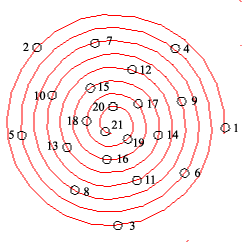Fibonacci Flowers — Where Nature and Math Collide
by Ray Novitske, Fairfax Master Gardener
 Fibonacci patterns are found throughout the plant world, such as in the seed head arrangements of sunflowers and coneflowers, the branching of trees, and the rings on pineapples. To understand what Fibonacci patterns are and why they occur, settle in for your math class.
Fibonacci patterns are found throughout the plant world, such as in the seed head arrangements of sunflowers and coneflowers, the branching of trees, and the rings on pineapples. To understand what Fibonacci patterns are and why they occur, settle in for your math class.
Leonardo Pisanoa Fibonacci was an 11th century Italian mathematician famous for bringing the Arabic numbers we use today to the merchant world to replace the cumbersome Roman numerals. He also pondered (mathematically speaking) the successive reproductive growth of rabbit populations. He wondered, How many rabbits would we have if a pair of rabbits produces another pair, and that second pair produced a pair along with the first pair, and each successive pair produced a pair along with the previous pairs?
 He found the answer by applying an old Indian Hindu numbering sequence to develop a formula calculating the count over time. The Hindu sequence is what we in our Western-centric society now call the Fibonacci sequence. The sequence adds the previous two numbers in a series of numbers to arrive at the next one ( 0, 1, 1, 2, 3, 5, 8, 13, 21, 34, 55 … ). Any number in the sequence is the sum of the previous two.
He found the answer by applying an old Indian Hindu numbering sequence to develop a formula calculating the count over time. The Hindu sequence is what we in our Western-centric society now call the Fibonacci sequence. The sequence adds the previous two numbers in a series of numbers to arrive at the next one ( 0, 1, 1, 2, 3, 5, 8, 13, 21, 34, 55 … ). Any number in the sequence is the sum of the previous two.
But nature had already invented this and was using it in all sorts of ways. The mathematical logarithmic spiral of a nautilus shell, the branching of certain trees, and the spiral seed arrangements of flowers all use this sequence or a formulation of it.

Chamomile head showing seed arrangement in 21 (blue) and 13 (aqua) spirals
The leaves of a stem and the branches on a tree also grow to produce a Fibonacci sequence. The tree leaves grow in a spiral pattern around the branch as new leaves form out at the ends. To test this for yourself, start counting with a leaf and count around the branch and downward towards the trunk. Count the leaves and also count the number of turns around the branch, until you return to the original position of the first leaf but further down the branch. Both the number of leaves and the number of turns around the branch will be Fibonacci numbers.

Leaf growth around tree branch – 13 leaves grow within 5 spiral turns
| Tree | Leaves | Turns |
| Elm | 2 | 1 |
| Cherry | 3 | 2 |
| Beech | 3 | 1 |
| Poplar | 5 | 2 |
| Willow | 8 | 3 |
| Pear | 8 | 3 |
| Almond | 13 | 8 |
How do these arrangements in nature happen to follow such mathematical formulas? With natural selection, the best-suited plants had the characteristics that offered advantages for survival. Plants that packed the most seeds into their seed heads had more chances to reproduce than those that didn’t. These flower seed heads develop by producing seeds from a center over a fixed time period at a regular rate. And, each individual seed grows so that the outer seeds produced first are larger than the inner seeds produced last. As long as the seeds are all the same shape and proportion, but slightly different in size due to their growth, we get the spirals.

Opposite spirals on a sunflower seed head
| Number of Seed head Spirals | ||
| left | right | |
| Daisy seeds | 21 | 34 |
| Aster | 13 | 21 |
| Pineapple | 8 | 13 |
| Pine cone | 8 | 13 |
| Sunflower | 55 | 89 | Coneflower | 12 | 21 |
There is no better or more efficient way, given the way seeds or leaves are produced in these plants, to condense more seeds into the seed head or grow leaves on a branch. Nature found the best method. Genius.
References
• The Fibonacci Numbers, Innovation Factory
• The Fibonacci Sequence, Spirals and the Golden Mean, Dan Reich, Department of Mathematics,
Temple University
• Phyllotaxis: The Fibonacci Sequence in Nature, Nick Seewald, University of Michigan
• Fibonacci in Nature, Nikhat Parveen, University of Georgia
• Fibonacci Spirals In Plants, Department of Mathematics, Statistics, Computer Science, University of
Illinois Chicago